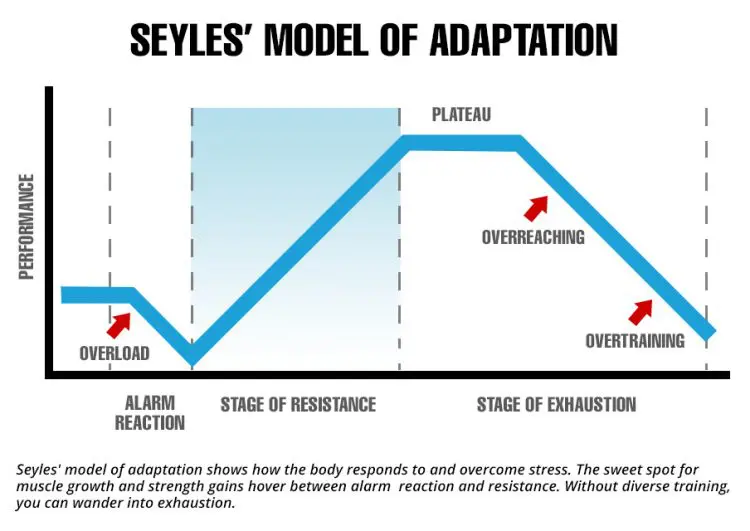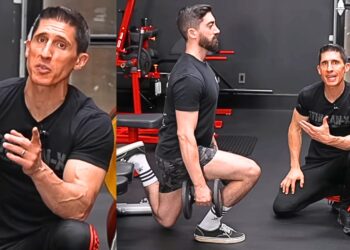A few years ago, I had to have surgery. It wasn’t anything serious, but I knew it was going to keep me out of the gym for a couple of weeks. For a self-diagnosed workout junkie, that was a tough pill to swallow! I was dreading losing hard-won strength and size, but the time off was unavoidable.
I started thinking about how I could use this break from training to my advantage.
That’s when I remembered a technique called strategic overreaching, which is something that some bodybuilders, powerlifters, and athletes do in the lead-up to a big event.
The concept is simple; you increase workout intensity and volume to take yourself to the brink of overtraining, take a break to deload, and then bounce back stronger than before.
Inspired, I created the program in this article.
It’s tough, but that’s why it works.
Level Up Your Fitness: Join our 💪 strong community in Fitness Volt Newsletter. Get daily inspiration, expert-backed workouts, nutrition tips, the latest in strength sports, and the support you need to reach your goals. Subscribe for free!
If you’re facing a break from training, maybe for a vacation, or you’re simply stuck in a rut and need to shock your body back into making progress, this workout plan is the one for you.
Be warned; it’s only seven days long, but it’s liable to be the most challenging seven days of training you’ve ever done.
Simply Brutal: 7-Day Workout Plan Overview
Most body part split workouts involve training major muscle groups once a week. Some train each muscle group twice, and a few even hit each muscle group three times a week.
This program laughs in the face of such conservative workouts and involves training each major muscle group seven times in seven days!
While this might sound ludicrous, it’s important to remember that you’re only going to follow this plan for one week. After that, you can rest and recuperate for a week before returning to the gym.
In simple terms, training your entire body seven times in a row will cause massive muscle breakdown. But, when you rest and deload, you’ll bounce back so that, when you begin your next workout cycle, you’ll be stronger and more muscular than you were before. This is called supercompensation.
To make such high-frequency workouts manageable, you’ll be doing abbreviated full-body workouts focusing on a small number of compound lifts. To avoid boredom, each workout features different exercises and set/rep schemes.

There are no isolation exercises in the workouts; you’ll need to save your energy for the big lifts. But, don’t worry, your biceps, triceps, and core will get plenty of work, albeit indirectly. If you feel you MUST do some curls, pushdowns, or crunches, do them after the main exercises.
You’ll also see that there are no direct shoulder exercises in the workout plan. That’s because your delts are worked indirectly in all upper body exercises. Don’t worry; your shoulders won’t shrink just because you don’t do any overhead presses for a week!
If you are worried about missing your delt workouts, feel free to add a couple of sets of shoulder presses or lateral raises at the end of a few of the workouts. However, it’s really not necessary.
The 7-Day Workout Plan

Needless to say, this workout plan is for intermediate and advanced exercisers only. If you have less than two years of training under your lifting belt, this is not the program for you. It’s also not suitable for anyone carrying injuries or during periods of high emotional or physical stress.
But, if you are looking for a challenge, need to bust through your current training plateau, or want to gain rather than lose strength and muscle during your next workout layoff, this program will help.
Start this workout program on Monday and train every day, seven days straight. At the end of your training week, take a seven to ten-day break and deload. Pay extra attention to rest and recovery both during the program and during your deload.
While you can change the exercises if required, make sure you stay true to the spirit of the program. So, while swapping squats for leg press is acceptable, replacing pull-ups with biceps curls is not.
| Days | Squat Movement |
Pressing Movement |
Pulling Movement |
Deadlift Movement |
| Monday | Back squat | Barbell bench press | Pull-ups | Conventional deadlift |
| Tuesday | Front squat | Incline DB bench press | Chin-ups | Deficit deadlifts |
| Wednesday | Zercher squat | Paused bench press* | Chest supported rows | Romanian deadlifts |
| Thursday | Box squat | Close grip DB press | Lat pulldowns | Paused deadlift* |
| Friday | Goblet squat | Decline bench press | Seated cable rows | Snatch grip deadlifts |
| Saturday | Anderson squats | Close grip bench press | Single-arm DB rows | Sumo deadlift |
| Sunday | Paused squat* | Incline bench press | Pendlay row | Rack pulls |
* pause mid-rep for 2-3 seconds.
Remember to start each workout with a general warm-up. 5-10 minutes of light cardio will help raise your core temperature, followed by a few dynamic mobility and flexibility exercises to prepare your joints and muscles for what you’re about to do. Expect to need a longer warm-up as your training week progresses; you’re going to feel tired, sore, and beat up.
Sets and Reps and Weights
You’ll be using a different set and rep scheme on each training day. This will prevent boredom and also exposes your muscles to even more variety.
Level Up Your Fitness: Join our 💪 strong community in Fitness Volt Newsletter. Get daily inspiration, expert-backed workouts, nutrition tips, the latest in strength sports, and the support you need to reach your goals. Subscribe for free!
The set and rep schemes for your week of training are as follows:
| Monday | 5 sets, 5 reps |
| Tuesday | 3 sets, 10 reps |
| Wednesday | 4 sets, 6 reps |
| Thursday | 6 sets, 3 reps |
| Friday | 2 sets, 12 reps |
| Saturday | 4 sets, 8 reps |
| Sunday | 8 sets, 1 rep |
A lot of workouts prescribe weight based on your one-repetition maximum, or 1-RM for short. That won’t work with this plan because you won’t know your 1-RM for all the exercises, and, even if you did, you’ll be more tired than usual, so these weights would not be valid.
So, instead, you’re going to establish your maximum for each exercise by ramping up as part of your warm-up.
For example, let’s say you are doing squats, and the workout called for five sets of five.
Starting with the empty barbell, do five reps. Rest a moment, add some weight, and do five more reps. Continue this process until the weight starts to feel reasonably challenging. That’s your training weight for the day, and you should use it for your remaining sets.
It doesn’t matter if your workout of the day calls for 10 reps per set or one rep. Start with an empty bar and ramp up until you feel that you’ve reached the right training weight for that day.
This method means you aren’t locked into using a predetermined weight and can modify the load based on how you feel each day. It’s a form of self-regulation. Over the course of your training week, you’re going to have good days and bad days; it’s all but inevitable. Establishing your training weight day by day allows for these unavoidable energy fluctuations.
7-Day Workout Plan Nutrition
Training all your major muscle groups seven days in a row is going to take a lot out of your body. Nutrition has never been so important! Make sure you fuel your workouts with plenty of nutritious food.
Calculate your TDEE and eat AT LEAST 500 calories more than the amount indicated. Push this up to 1000 calories above TDEE if you feel like you need to.
This is not a time to experiment with the latest fad diet, and things like intermittent fasting and keto are not a good idea either. Instead, you should eat big to get big – it’s bulking time!
Take a page from the old-school book of nutrition and fill up with plenty of wholesome foods. Each meal should contain a source of protein, whole grains, vegetables, and healthy fats. The occasional sugary treat won’t hurt, either.
You may also find certain supplements useful during this short but intense training program. Good options include:
What Comes Next?
By the third day of this workout plan, you’re going to start to feel tired. You’ll have to pump yourself up and stay motivated to complete all seven days, so stay strong – you CAN do it!
After your seventh workout, it’s time to enjoy a 7 to 10-day deload and let your body recover, recuperate, and grow. It’s crucial that you stay out of the gym for at least a week and allow supercompensation to occur.
Enjoy your time off – you’ve earned it. But, don’t just spend the week being physically inactive. Keep your body moving to avoid seizing up and to speed up the recovery process.
Good options include:
- Walking
- Swimming
- Get a massage
- Try contrast (hot/cold) therapy
- Use a foam roller
- Stretch
Read more about the methods you can use to enhance recovery here.
Spend your recovery time planning your next phase of training. You could even write your own bodybuilding workout or try one of the many training programs on Fitness Volt.
Despite having had a week off from training, don’t be surprised to find that you actually feel stronger than you did at the end of your week of workouts. After all, that was the aim of the program.
Don’t be tempted to do this 7-day workout plan again too soon; it’s undeniably effective, but it will lose its potency if you do it too often. 2-3 times a year is best. Do it more often than that, and you’re liable to just end up injured and overtrained. It’s too stressful for regular use.
7-Day Workout Plan – Wrapping Up
The 7-day workout plan is not for the faint-hearted. Training your major muscles every day for a week is going to leave you tired and sore. This program is designed to take you to the very edge of overtraining. It may even tip you over the edge!
But, it’s only by pushing the envelope and driving your body beyond its normal limits that your muscles get bigger and stronger. With adequate rest and recuperation, your body will bounce back, and you’ll enjoy a big jump in progress.
Whether you are stuck in a training rut, and want to smash through your current plateau, or are facing an enforced break from training, this workout will help. But, it’s meant for intermediate and advanced lifters only; it’s way too demanding for beginners!












